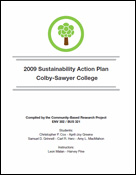Colby-Sawyer College Sustainability Action Plan
Global climate change is a prime issue that has become an indisputable concern as more and more evidence links human activities to the changing climate. The scientific consensus supports this claim by providing well documented evidence of glacial retreat, sea level rise and increasing CO₂ concentrations in the atmosphere. The fight against climate change is gaining speed as more citizens, organizations and countries become better educated and willing to incorporate environmental stewardship into their policies, laws and norms. Ann Rappaport, an urban environmental policy professor at Tufts University and author of Degrees that Matter”, states that colleges and universities must take the lead in climate action. She establishes a link between the future generations who would be affected by climate change and a college or university's power to promote environmental awareness and actions to prevent such a change to these future generations. Furthermore, as Rappaport acknowledges, these environmental actions and policies have the potential to save the institution significant amounts of money every year.
Colby-Sawyer College recently signed The American College and University Presidents Climate Commitment (ACUPCC). This action demonstrated Colby-Sawyer College's sincerity to play an active role in the fight against global climate change. The ACUPCC is a collaborative effort across American colleges and universities who have opted to take a lead in reducing emissions and lessening their ecological footprint. To date, the ACUPCC has 621 signatories representing colleges from all 50 states.
GreenROUTES 2008-2009 worked with the college to meet the reporting commitments of the ACUPCC. Data collection and a spreadsheet developed by “Clean Air-Cool Planet” helped to determine that Colby-Sawyer College's net emissions of CO₂ for the 2008 financial year were 7,637 metric ton of CO2 this information is now contained in a Greenhouse Gas Inventory report that is publically available on the ACUPCC reporting page.
Table 1. Colby-Sawyer Emissions from Two Major Energy Sources |
|||
| Year | Propane (Gallons) |
Electricity (kWh) |
Total Metric Tons CO2 emitted (All Sources) |
| 2006 | 485,255 | 3,708,090 | 8,070.1 |
| 2007 | 522,368 | 3,691,240 | 8,044.9 |
| 2008 | 469,769* | 2,484,209 | 7,637.1 |
| NOTE: Colby-Sawyer College has experienced a downward trend in emissions since the two largest contributors have decreased in the last three years. *Installation of new windows over the summer of 2007 could be the cause of this reduction. |
|||
The second semester was spent researching and gathering data to bring together this Sustainability Action Plan. In order to create sustainable policies, GreenROUTES identified five major themes: energy, water & biodiversity, food, waste & consumption and culture, curriculum & investment. Chapter 1 of this document details the history and progression of GreenROUTES at and its efforts to promote sustainability throughout the Colby-Sawyer College community. Chapter 2 describes the ACUPCC's required greenhouse gas inventory, which was calculated using the “Clean-Air Cool-Planet” carbon emissions calculator. The emissions are divided into 3 scopes to allow for a more thorough analysis of the emission sources. Chapter 3 consists of benchmarking analysis, which involved comparing Colby-Sawyer College to other colleges with similar characteristics in sustainability efforts. In Chapter 4, GreenROUTES evaluates Colby-Sawyer College's sustainability level based on the Sustainability Tracking, Assessment and Rating System (STARS) report, a multi-approach test that assesses sustainability within colleges on a myriad of levels. Using this assessment, GreenROUTES found opportunities within many areas of the college to promote sustainability, and used it to develop policies in each of the 5 focus areas. The results of the assessment showed that Colby-Sawyer scored only 12 out of 167 points, or 7%.
Chapter 5 details over 30 specific policies divided into 3 tiers. The tiers are divided by convenience of implementation, cost of implementation, and the extent to which it would meet ACUPCC policy commitments. For instance, Tier 1 policies can be introduced easily and inexpensively within the next year and will help the college meet ACUPCC policy commitments. Tier II policies are more likely to take 2-3 years to consider, and execute, and Tier III policies are the most investment intensive. This does not make Tier III policies less important. In fact, the potential savings and emission reductions are highest for Tier III policies. Tier III policies are recommended for implementation in 5 years or more. The 6th and final chapter of the report lists our conclusions and recommendations.



